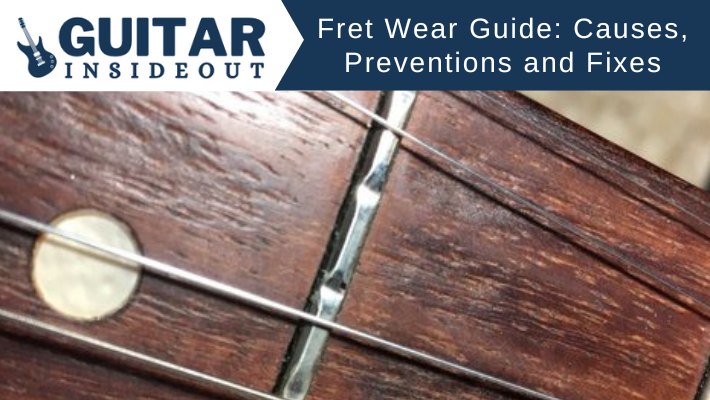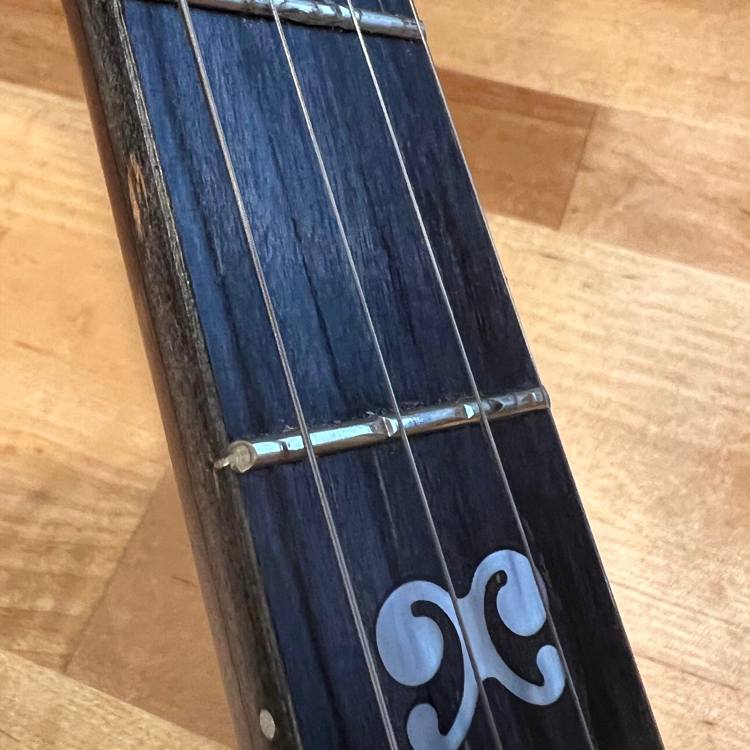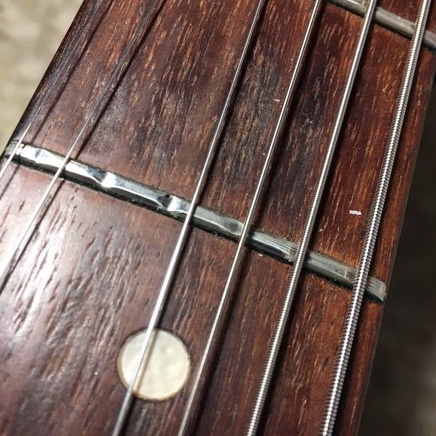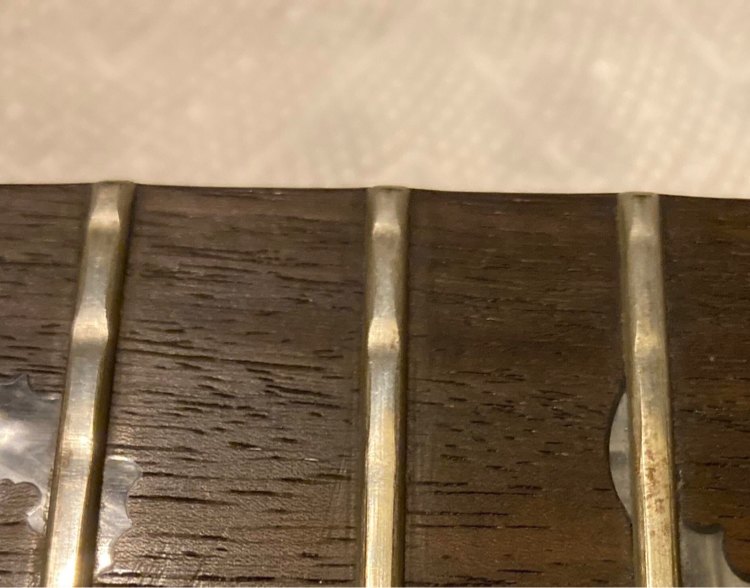Guitars, like most things in life, are susceptible to wear and tear. Even if you look after it like it’s your child (and let’s be honest – we do) if you play it regularly it’ll begin to show some signs of wear.
The strings need changing, the finish gets chipped and dinged, the electronics can break etc. And one of the areas you are most likely to encounter that wear is the frets.

Fret wear is a common issue. But if you’re trying to diagnose it, unsure what to look for or what might be a reason for worn frets then keep reading.
This article will look at what fret wear is, what causes it, how to prevent it and more.
What is Fret Wear
Fret wear is when the frets of a guitar become flat or divots, pits and grooves form in them. When a guitar is played for a long time frets will begin to wear down. The material the frets are made from can affect how fast this happens with certain types of frets being more durable and lasting longer.
Frets are made up of:
- The Tang – this is the part that is glued into the slots in fretboard and so you don’t see it.
- The Barb – is a row of hooks that secures the fret to fretboard.
- The Crown – the part you do see and that you press the string against.
The crown can become flattened with use or develop grooves where the strings have rubbed against them. This affects the way the guitar plays and sounds.
Fret wear usually requires some work done to it to fix the issues it causes.
What Causes Fret Wear
Fret wear is caused by playing your guitar. The more you play, the more you are pressing the strings down against the frets. That repeated contact and pressure of the metal guitar strings against the metal frets causes flat spots. Those spots eventually get worse and become deep grooves.
The way in which you play can have an impact on how quickly your frets wear out though. If you use very heavy gauge strings, have a playing style that really digs in and does lots of big bends and you play for hours at a time then you’ll go through frets pretty quickly!
On the other hand if you play extremely lightly and not very often then your frets will last a lot longer. There are people who play for years and years without needing a refret.
Your fingers will also contribute to the wearing down of frets. Sweat from your skin can be acidic and corrode the frets faster than they might have.
Also a poor setup can contribute to frets wearing faster than they would. High action and the need to really press hard to hold the strings down will speed up the wear on your frets.

What About Capo’s?
Using a capo definitely contributes to fret wear. Even more so if you use the capo at the same fret a lot.
When you use a capo it really pushes the strings hard against the frets. Far more so than you could do with your fingers.
So it’s no surprise that a capo pushing the strings into the frets constantly for any length of time will worsen fret wear.
A way to avoid this is by getting a tension adjusting capo. This allows you to adjust the tension the capo is placing on the strings, letting you reduce it to just enough that your capo frets the strings but not so much it will really exacerbate wear.

Is Fret Wear Bad?
It definitely can be! Some wear isn’t a problem. It may not affect how the guitar plays and be purely cosmetic.
But it’s when the worn frets start to impact on the playability of the guitar that you have issues. And worn frets can make your guitar play really badly.
They cause rattling and fret buzz as well as issues with the intonation. Vibrato and bends can become near impossible or just sound awful.
Very worn frets can even lead to fretted notes being out of tune or not sounding at all. If you’ve reached that point then you’re going to have to go think about taking action. That could be a fret dressing/levelling or even complete refret.
What Does Fret Wear Look Like
Worn frets are easy to identify. In moderate cases the frets will look flattened and not rounded like they should be. In worse cases you will notice grooves and divots within the fret itself and under where the string sits.

Also look for the tops of frets becoming flattened. They should be slightly rounded. You can use your fingers to touch as well as just looking.
The crown of the fret, which is the top party should be directly above the fret slots. If it’s not that is another sign of issues with your frets.
How to Check for Worn Frets
It sounds silly but you just look at the frets. If it’s really bad you will be able to see the wear clearly – there will be deep furrows or grooves in the frets.
If the wear isn’t that bad then you will want to look very closely at the frets. Make sure the lighting is good and move the strings to the side to give yourself the best visibility.
There may be pitting and some small dents. Possibly what looks like the shine has been scraped off the frets.
Aside from those visual signs you need to look out for changes in how your guitar feels and plays. If you’re getting fret buzz or notes choking out when you bend then that might be because of fret wear too.
It could be many other things of course and it’s important to diagnose the cause correctly. But if you are experiencing anything like that you can take a look at your frets to see if there is any wear. If so it could well be the reason.

How to Prevent Fret Wear
There are some things you can do to prevent fret wear or at least slow it’s development down:
- Always wash your hands before playing the guitar. You want to get any oils and dead skin off your hands and fingers before putting them on the strings.
- Wipe your strings after each use. This keeps them clean and stops the build up of dirt and corrosion.
- Replace your string’s regularly. Don’t let them get rusty or coated with grime, dirt or sweat before changing them.
- Store your guitar somewhere dust free. Dust collects on strings, especially if the strings have sweat from your fingers still on them. That dust in turn contributes to corroding the strings which will wear the frets faster.
- Play lightly! Avoid a death grip on the strings when you play. Try to find the minimal amount of pressure you need to hold the strings down and still get the note to sound. Practice only using that amount of pressure and with time it’ll become natural and save your frets from wearing out prematurely.
- Try not to use a capo too much. If you must then use a tension adjusting one.
- Use lighter gauge strings. The heavier the string gauge the more pressure it will place on the frets. You will also find yourself having to press down harder. So if you can use as lighter gauge as possible.
- Get a good setup. Having too high action will result in you pressing harder on the strings. This in turn will lead to quicker fret wear.
- Polishing your frets regularly can help them last longer. It can increase the frets resistance to corrosion and so they wear down more slowly.
- Stainless steel frets last a lot longer than regular fretwire made from nickel. So you could think about getting a refret with stainless steel frets, although this is a fairly expensive option.
You don’t have to do every single one of these to prevent fret wear. For example if you like using a capo a lot or prefer heavier strings then don’t stop.
Just be aware it will be a contributing factor to your overall fret wear. And following as many of the tips listed above as you can will help to reduce the speed of those frets wearing out.
How Much Fret Wear is too Much?
When it starts to impact on how the guitar plays. If you’re getting buzzing, rattling or dead notes because of fret wear then it’s time to do something about it.
If you aren’t noticing any problems because of worn frets then there isn’t a problem.
How to Fix Worn Frets
There are a few ways to fix frets that are worn to the point of them affecting how your guitar plays. All of these can be done yourself and there are good tutorials on YouTube.
However, if you don’t know what you’re doing, don’t feel confident or your guitar is valuable/means a lot to you it might be best to get a professional to do it. Learning to do your own setups and things like fret work is a good idea but it’s best to start on an old guitar you don’t care about in case you make any major mistakes.
Fret Levelling and Crowning
Fret levelling and crowning is when you sand or file down the tops of the frets to make them all level. This can be done as long as the fret is tall enough.
Once the fret is sanded down it will need re-crowning as the process of sanding will have left the fret flat. This is the trickiest part and usually requires someone with a lot of experience to do.
Fret levelling is also commonly known as fret dressing.

Refret
A refret is when every single fret on the guitar are removed and replaced with new ones. It’s needed if the frets have become too worn and there isn’t enough height left in the frets to level and crown them.
A refret is a major undertaking and has many complex parts and steps to it. If you aren’t a professional guitar tech or luthier be very careful if you attempt it yourself.

How Do You Decide if you Need a Fret Levelling or Refret?
It will come down to how much wear there is and how much fret material you have left. A fret levelling and crowning will always be cheaper so if there is enough height left in the frets for that to be an option choose that.
However if the frets are already very low or the wear is extensive then it’s probably going to have to be a refret.
FAQ
Do Some Guitars Frets Wear Out Quicker Than Others?
Yes, some frets do wear out quicker than others. This is due to the material the frets are made from.
Most frets are made from nickel alloys and most guitar strings are made from nickel too. They wear each other out by pressure and corrosion.
Stainless steel frets are a lot harder than a nickel alloy and so the wear from regular nickel strings is much less. They aren’t found on many guitars though and instead are often used as replacements when nickel frets have worn out.
Why Do My Frets Wear So Fast?
This could be the way you play your guitar or how it is setup. Examine how hard you’re pressing the strings and aim for a lighter touch.
Are you doing lots of bends and vibrato? This wears frets quicker.
And how is your guitar setup? Is the action high? And if so, is that making you press harder on the strings than you might otherwise need to. This could cause frets to get worn down faster than most.
How Long Do Frets Last?
There isn’t a definitive answer to this. It could be months if you’re playing a lot and aggressively. If you have a light touch it should be years. It may even be decades if not forever if you don’t play that often! Brian May claims his ‘Red Speial’ guitar has never been refretted!
The best thing to do is try to play as lightly as you can, keep your strings clean and well looked after and make sure your guitar is well setup. If you do all those your frets should have a good lifespan.
How Much Does a Fret Levelling Cost?
It depends on the luthier but an average cost of a fret levelling should be around $70-100. This would include re-crowning, polishing the frets and cleaning the fretboard.
How Many Times can a Guitar be Refretted?
A guitar can be refretted up until the fret slots become too wide. This can occur after a number of refrets as each tube you remove and replace the frets it widens and weakens the slots.
Those slots can be saved by filling them in to narrow the widening. But it does become a tricky job, which on top of an already tricky refret can make the entire process long and awkward.
But it means that technically a guitar can be refretted as many times as you like. It just gets more and more difficult and eventually might become impossible.
Can you Wear Out Stainless Steel Frets?
Yes, stainless steel frets do wear out. It takes much longer than nickel frets but if you use cobalt or stainless steel strings on them then they will eventually wear down.
Regular nickel strings against stainless steel frets should last decades before any major wear though, if not longer.
I just spent $350 on an entire refretting on my Taylor 614ce. With the new frets I’m feeling lots of friction and/or difficulty sliding up and down the fretboard. What is the reason for this? Could it be the type of wire, the crown size, width, height or what? I dont know and cannot pinpoint the problem probably because I don’t understand too much about the facts. It’s not often I get my guitars refretted.
if they feel rough when bending a string up and down it sounds like they replaced the frets but didn’t dress them.
if they feel like railroad tracks when you run your fingers along the fretboard they probably put in tall/narrow frets and you’re used to lower jumbo ones that have a softer feel